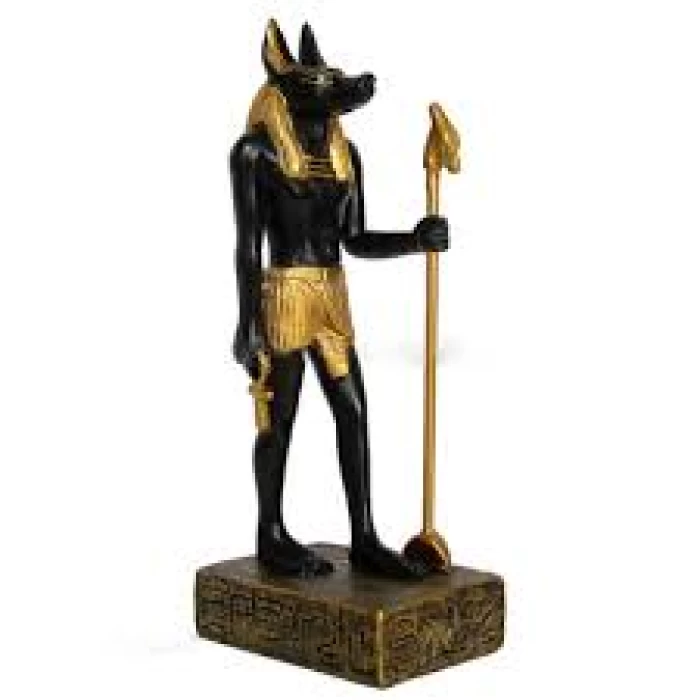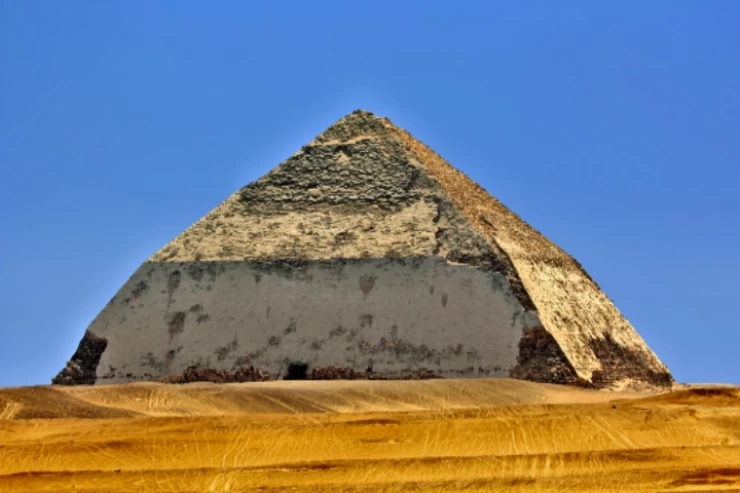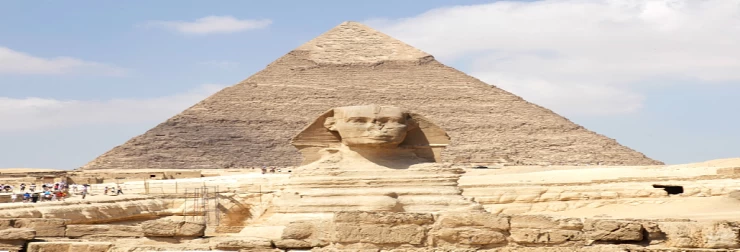
Anubis: Guardian of the Underworld and Protector of the Mummified Dead in Ancient Egypt
nubis is the Egyptian god of mummification and the afterlife, as well as the patron god of lost and miserable souls. Anubis is one of Egypt's oldest gods, and he was descended from the much older jackal god Woebot, so people often confuse the two. Egypt Day Tours and Egypt Travel Guides often highlight Anubis due to his prominent role in Egyptian mythology, where he is depicted in royal tombs from the first Egyptian dynasty (3150-2890 BC). However, it's believed a cult worshipped Anubis even before this period, praying to him on tomb walls for protection.
Anubis is thought to have emerged in response to wild dogs and jackals digging up graves, around Egypt's pre-dynastic period (6000-3150 BC), when Egyptians believed in a powerful dog-like deity to protect them from wild animals. Anubis was depicted as a black dog or a cross between a dog and a jackal with pointed ears, or as a muscular man with a jackal's head. The color black symbolized decay and renewalᅳideas connected with the Nile Valley's fertile soil. This symbolism is explored in Egypt Travel Packages and Egypt Shore Excursions, revealing how ancient Egyptians saw Anubis as the protector of the dead, who ensured the deceased's rights in burial and helped them on their journey to the afterlife.
Anubis held the title “First of the Westerners” before Osiris emerged during the Middle Kingdom (2040-1782 BCE) as “King of the Dead.” Anubis was associated with eternal justice and continued this role even after Osiris replaced him as the primary god of the dead. Originally considered the son of Ra and Hest, he was later seen as the son of Osiris and Naftis, Osiris's sister-in-law. Anubis was the first god depicted on tomb walls, dedicated to protecting the dead. He's often shown overseeing embalming rituals or standing next to Osiris, Thoth, or other gods during the weighing of the heart in the Hall of Truth.
In famous images, Anubis is seen as a jackal-headed man holding golden scales to weigh the soul's heart against the feather of truth. His daughter Kabhet brings cold water to the souls of the dead in the Hall of Truth, offering comfort to the recently deceased. His ties with Naftis, known as the friend of the dead, emphasize his role as a protector and guide in the afterlife.
The name Anubis derives from the Egyptian Anpu or Inpu, meaning rotting, symbolizing his association with death. Known also as “Lord of the Sacred Land,” he protected the desert Necropolis, “He who is on his sacred mountain,” watching over burial sites, and “Ruler of the Nine Strangers,” a title referring to Egypt's enemies. As “the dog that swallows millions,” Anubis was revered as the god of death, “master of secrets,” knowing what lies beyond death, and “the most important in the divine chamber,” for his presence during embalming and burial.
Judging from his attributes and titles illustrating his role (as a protector who judges and guides the soul), Anubis was a vital figure in death. Researcher Gera Ledeen Pinch states, “Anubis helped to judge the dead, and heᅳand his army of messengersᅳwere tasked with punishing those who desecrated tombs or insulted the gods.” Anubis's influence extended to those who fostered chaos.
During the First Dynasty (3150-2613) and the Old Kingdom (2613-2181), Anubis was the sole master of the dead and judge of souls. However, as Osiris's popularity rose, he assumed many of Anubis's attributes. Anubis's origin and history were eventually revised, making him the son of Osiris and Naftis, products of their love affair. In this story, Naftis (wife of Set) was attracted to Set's brother Osiris, transformed into Isis (Osiris's wife), and conceived Anubis. Afraid of Set's anger, Naftis abandoned Anubis, whom Isis later found and adopted. Set discovered the affair, leading him to kill Osiris.
Once integrated into the Osiris myth, Anubis became Osiris's protector, guarding his corpse, supervising mummification, and helping Osiris judge the dead. Amulets and tomb paintings reveal how people invoked Anubis for protection and even revenge, with some casting curses in his name as defense against curses cast by others.
Ancient Egypt boasted many great monuments and left us a cultural legacy unparalleled among other civilizations, one that we are still proud of and distinguished by to this day.
One of the hallmarks of ancient Egypt's greatness was its recognition of the one god, its sanctification of him, and its devotion to him, offering sacrifices to him. Not only that, but its loyalty to the god extended to the construction of temples and the inscription of his symbols on walls. The god was represented in animals, plants, and birds, and was considered a symbol of the goodness that God bestowed upon the people of Egypt.
The title of god given to these sanctuaries was not intended to refer to the supreme god, the creator of the universe. Rather, it was a specific god associated with a specific aspect of life, such as agriculture, rain, life and death, the Nile, air, and fertility...Anubis, the ancient Egyptian deity of the dead, tombs, and mummification, is the most well-known of these gods.
Reason for his sanctification: The ancient Egyptians took Anubis as their god, seeing him as the archenemy of the dead, as he would dig up graves and tamper with the bodies of the dead. This was the reason behind his sanctification as the lord of the dead and protector of cemeteries, in order to ward off his evil.
Anubis was known as the god of the underworld but later he became associated with the mummification process and the funeral processions. His name was changed and he was then known as "Imy-ut" (He Who is In the Place of Embalming), nub-ta-Djoser (lord of the sacred land). Preserving the body of the dead person was one of the ancient Egyptian beliefs that's why they mummified their dead, Anubis was the mummified god.
The head of a jackal, an animal connected to graveyards and death, is frequently used to represent Anubis. This relationship was probably prompted by the ancient Egyptians' observations of jackals wandering near cemeteries. The presence of the jackal represented Anubis' function as a guardian of the deceased... Anubis, the symbol of judgment and balance, is the funerary symbol embodied in the image of a black animal from the wolf family (jackal).
The titles and names of this god are: "Leader of the Westerners" and "Leader of the Dead." Lord of the ancient Abydos necropolis. He takes the dog. From the end of the Old Kingdom, it became a title for the god Osiris after being merged with him.
The jackal is the sacred animal of the gods Wewawet and Anubis, the god of embalming.
The jackal, or wolf, led the deceased into the afterlife, sometimes taking the form of an animal (jackal). He was considered a great funerary god, and temples were dedicated to his worship in Middle Egypt, in a city the Greeks called Kenopoas, meaning "City of Dogs."
Anubis assumed various roles in different contexts. He was depicted as a protector of tombs as early as the First Dynasty (c. 3100 - c. 2890 BC). Anubis was also responsible for mummification. By the Middle Kingdom (c. 2055 - c. 1650 BC), he had been replaced by Osiris in his role as lord of the underworld. One of his most prominent roles was as a guide of souls into the afterlife.
We can see a lot of prayers and rituals dedicated to Anubis carved on many ancient tombs in Egypt. He watched the process of mummification of the dead to ensure it was proper. He accompanied the souls of the underworld while examining their knowledge of the gods and their faith. He placed the heart of the dead on the scales of justice when the judging of the heart took place.
Birth: He was the fourth son of the god "Ra". It was also believed that the god Anubis was the son of the goddess Nephthys and the god Osiris, after Nephthys, the wife of the god Set, fell in love with Osiris, the husband of Isis, and appeared to him in the form of his wife and became pregnant with Anubis. However, she was afraid of the god Set, so she abandoned Anubis. However, when Isis found out about the matter, she adopted him, and he later helped her in mummifying the god Osiris.
















